Michigan grape scouting report – Aug. 26, 2020
The warm, sunny weather has allowed sugar to accumulate in fruit. In southern Michigan, harvest of some early hybrid varieties will begin in the next one to two weeks.

Weather
The last week was more of the same across Michigan—sunny and dry. The week started cool, but highs quickly reached the mid-80s with lows in the 50s and 60s statewide. Northwest Michigan regions saw trace amounts of scattered showers. The rest of the state was untouched. A short-term heat wave entered southern Michigan on Sunday, Aug. 23, bringing temperatures near 90. A cold front is expected to pass into the area on Friday, Aug. 28, bringing a decent chance of rain and temperature drops of around 15 degrees. These lower temperatures should continue into the first part of next week.
The cooler, dry nights have slowed down heat accumulation. We collected fewer growing degree days (GDD) last week than the week before: 140 GDD base 50. The southwest region is 425 GDD base 50 ahead of the northwest region.
|
Northwest Michigan GDD summary from March 1 – Aug. 24, 2020 | ||
|---|---|---|
|
Northwest stations |
GDD 50 F |
GDD 47 F from wild bloom (grape berry moth model) |
|
Petoskey (Petoskey) |
1690 |
1553 |
|
Traverse City (NWMHRC) |
1854 |
1719 |
|
Old Mission (Old Mission) |
1796 |
1639 |
|
Avg for NW region |
1790 |
|
|
Average last week |
1651 |
|
|
Southern Stations |
GDD 50 F |
GDD 47 F from wild bloom (grape berry moth model) |
|
Benton Harbor (SWMREC) |
2275 |
2138 |
|
Lawton (Lawton) |
2234 |
2057 |
|
Fennville (TNRC) |
2068 |
1921 |
|
Avg for SW region |
2218 |
|
|
Avg last week |
2077 |
|
|
Romeo (Romeo) |
2163 |
1998 |
|
Romeo last week |
2022 |
|
Note: Wild grape bloom dates are estimates. See “Mid-season management of grape berry moth” for bloom dates.
Vine growth
Statewide, most grapes have completed veraison. Berries are close to full size. Some varieties are beginning to soften, acid levels are starting to drop. Harvest of early table grape cultivars will begin soon. Harvest of some early hybrid wine varieties such as Marechal Foch and Marquette will begin soon in the southern regions as well.
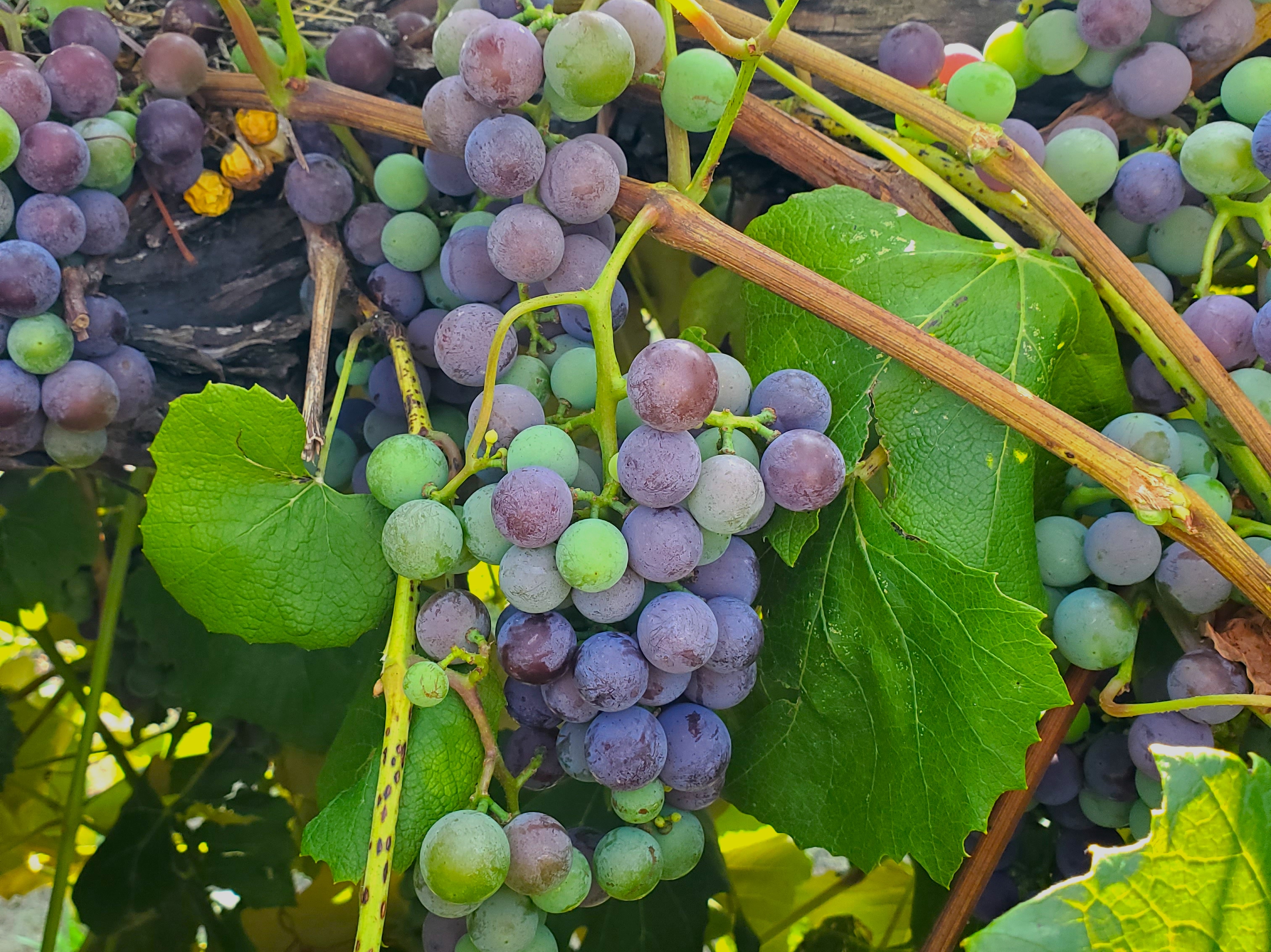
Crop adjustment work is underway, both mechanically using harvesters in juice grape vineyards and by hand in wine grape vineyards. The Michigan State University Extension bulletin “Predicting Harvest Yield in Juice and Wine Grape Vineyards (E3186)” provides tools to reduce both annual yield and quality variability among years by aiming for improved vine balance (fruit to vegetative growth). The intensity of crop thinning depends on the cultivar and vine vigor.
Veraison is also the time to plan for “green drop” to ensure the highest quality harvest for any specific cultivar. This technique reduces variability in fruit ripening by removing “green” fruit that are behind in maturation (selected at late veraison stage) so that uniform ripeness can be achieved at harvest for optimal wine quality. Growers or their vineyard workers can scout for clusters that are unlikely to ripen and remove them from the vine. Those clusters are usually green, in the wrong position in the canopy, or starting to show signs of infection.
During fruit maturation, bird damage is also a challenge in vineyards. Crop losses can reach up to 95% and 60% in red and white varieties, respectively. Several methods of protection can be implemented including the use of bird nets, streamers, scare-eye balloons, electronic bird distress calls and propane-fired bird-scaring cannons.
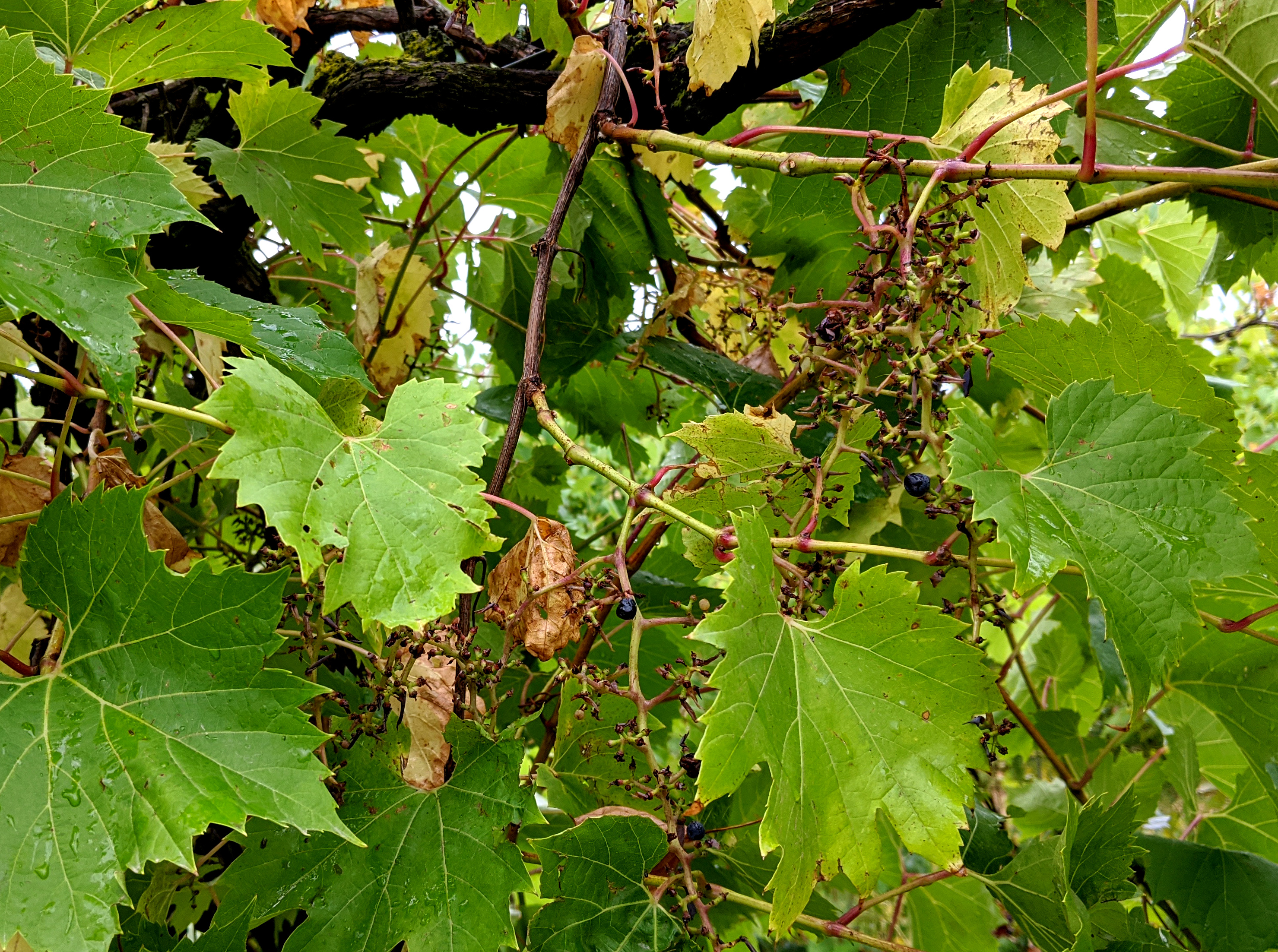
The window of time for collecting petiole samples for nutrient analysis is over in the southwest region, but there is likely still time in other regions. The information from petiole samples for foliar tissue analysis can be used to identify deficiencies and plan ahead for nutrient inputs for next season.
|
Variety |
Northwest region (degrees Brix) |
Southwest region (degrees Brix) |
|---|---|---|
|
Pinot Noir |
12 |
-- |
|
Pinot Gris |
13.2 |
13.2 |
|
Pinot Blanc |
9.3 |
-- |
|
Cabernet Franc |
7.9 |
13.5 |
|
Zweigelt |
13.2 |
-- |
|
Riesling |
5.6 |
-- |
|
Madeleine Angevine |
16.9 |
-- |
|
Chardonnay |
11.6 |
-- |
|
Cabernet Sauvignon |
-- |
17.8 |
|
Sauvignon Blanc |
-- |
15.6 |
|
Merlot |
-- |
16.4 |
|
Gewurztraminer |
-- |
13.3 |
|
Marquette |
-- |
20.2 |
|
Concord |
-- |
11.0 |
|
Niagara |
-- |
11.2 |
Weeds
Weed control is always an important component in vineyards for keeping grape vines healthy and ensuring good quality grape yield. At this time of the year, weed control in vineyards is mainly important to reduce weed interference in machine or manual harvest and to reduce the soil weed seed bank for the following season.
The application timing for most of the herbicides during this time of season is mainly based on the preharvest interval (PHI). PHIs have been established for most herbicides except for paraquat (Gramoxone). Aim (three-day PHI), Rely (14-day PHI) and Gramoxone (Restricted Use Pesticide) provide quick burn-down of weeds. Rely and Gramoxone control both broadleaves and grasses, but Aim is only effective for broadleaves.
Poast and Fusilade are selective, post-emergence grass killers and can be used in vineyards based on 50-day PHI. Venue (zero-day PHI) can be added to improve burn-down and broaden the weed control spectrum. Some herbicides will damage grape green bark, new shoots, leaves or vines, so minimize contact with vines during application.
Glyphosate also has a short, 14-day PHI, but it is not advisable to apply it after bloom. Significant injury may occur during the current season or the following year if glyphosate comes in contact with leaves, green shoots or is absorbed by bark.
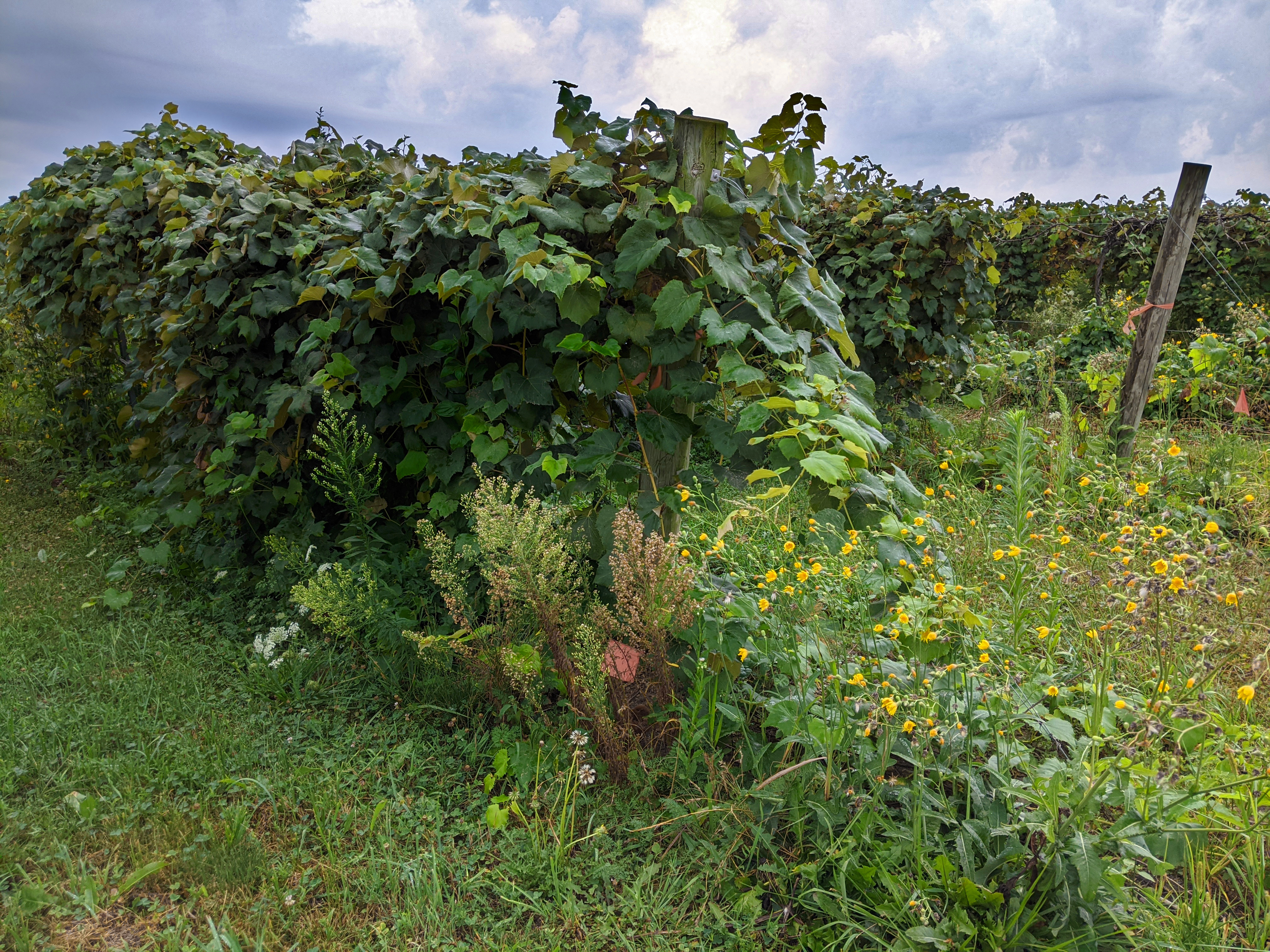
Diseases
The disease focus for most grape growers around Michigan is still on downy mildew and powdery mildew management, but cluster rots are becoming more important as Brix levels increase. This week, some southwest vineyards with early ripening hybrids are seeing botrytis symptoms. The time to manage sour rot is also approaching as berries begin to ripen.
At this time, we continue to be concerned about defoliation caused by downy mildew. This Michigan State University Extension article provides more information on late season downy mildew control.
Opening up the grape canopy for air movement helps reduce powdery mildew and allows for better spray penetration. Shoot positioning and cluster zone leaf removal can also help. For more information on how weather conditions affect powdery mildew development, see “Why some seasons are worse for powdery mildew” from Good Fruit Grower.
Several strategies contribute to good botrytis bunch rot management. These include opening up the canopy, properly applying fungicides and using resistant cultivars when possible. Good botrytis control depends on getting good coverage. Fungicide resistance management is also important. The most effective products for botrytis are site specific and prone to resistance development. A new Michigan Grape Fact Sheet is now available for managing botrytis bunch rot.
Sour rot can be particularly difficult to control on tight clustered varieties. Enhancing airflow through the canopy and clusters can help, so leaf pulling, thinning, shoot positioning and weed control can all provide some reduction in sour rot risk. Another important aspect of control is preventing berry damage (e.g., bird pecks, insect feeding and mechanical damage) to reduce the initiation of berry infections. Sour rot is beginning to show up in southwest Michigan in berries damaged by grape berry moth. Yellowjackets and drosophila flies are also commonly associated with damaged berries that develop sour rot.
Combining an insecticide with a contact fungicide can be effective in managing both the pest and the pathogen. In high risk cultivars (e.g., Vignoles) and in hot and humid conditions these treatments should be applied before symptom development and clusters have reached 13-15 Brix. Under high disease scenarios, treatments should be applied on seven- to 10-day intervals until harvest.
This is a good time to scout for suspicious issues related to other vine stressors. Many of these problems can be abiotic including nutrient related issues and graft incompatibility, but some of the biotic problems can be caused by grapevine trunk diseases or grapevine viruses. If you are interested in taking samples and testing, you can send them to MSU Plant & Pest Diagnostics. Please see these articles on grapevine trunk disease and sampling for grapevine viruses.
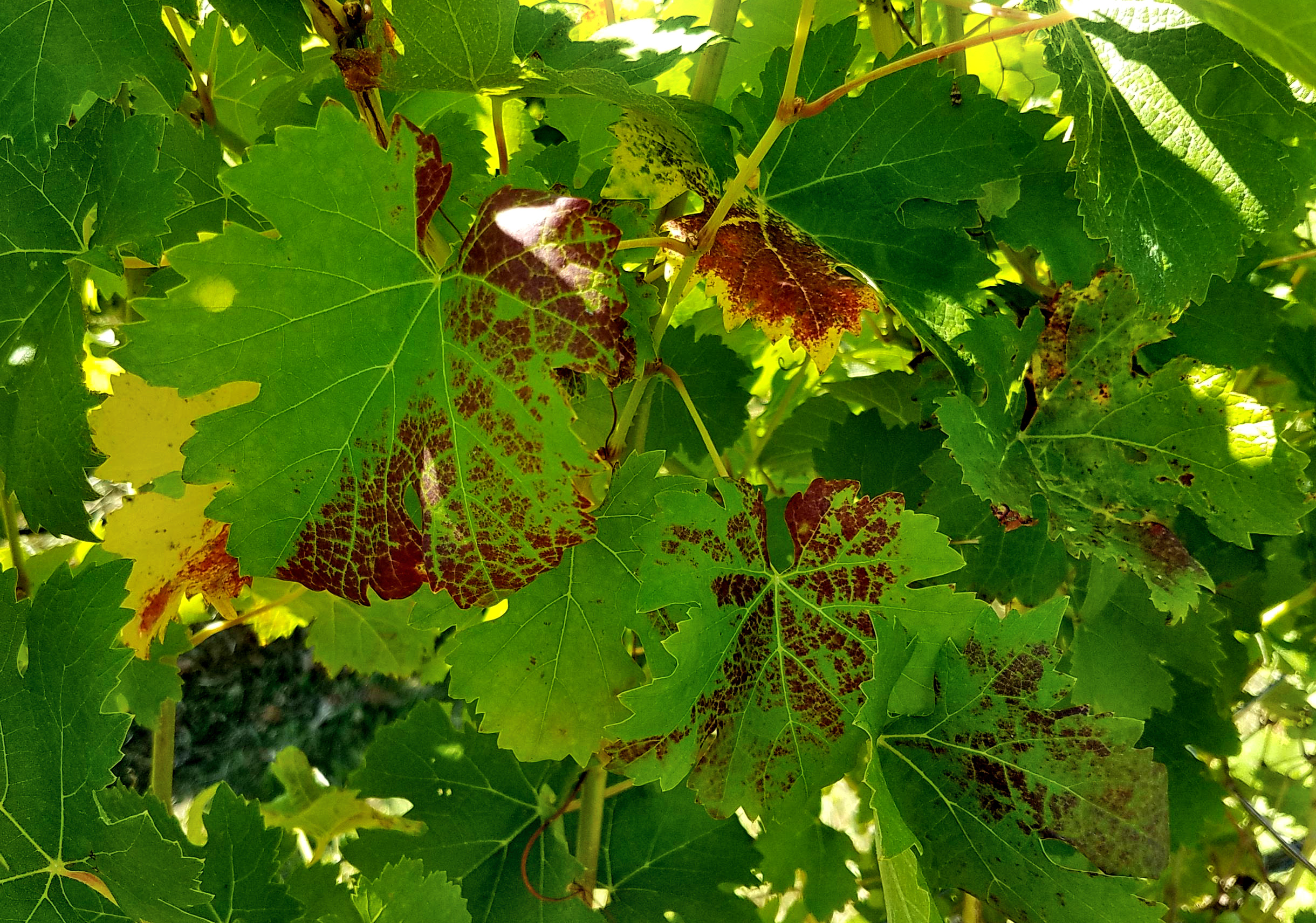
A complete list of grape fungicides can be found in the E154 Michigan Fruit Management Guide. Check the guide for potential phytotoxicity of certain sprays on Concord grapes especially. Phytotoxicity risk is higher with high temperatures and quickly growing vines. One important thing to remember at this time of year is to keep track of preharvest intervals for fungicides.
Insects
Grape berry moth damage continues to increase at the borders of many vineyards in southwest Michigan as generation three infestation becomes visible. Growers with problems from grape berry moth last year should be scouting and protecting vines through this current third generation. In high pressure sites, multiple insecticide applications may be needed. We provide guidance in this article: August is key time for protecting clusters from grape berry moth.
Yellowjacket populations are increasing in vineyards. They are attracted to the accumulating sugars in the berries. Yellowjackets can be very damaging to the berries directly, causing wounds that can lead to cluster rots and reducing harvestable crop. They can also be frustrating to sprayers and harvest crews, trying to avoid being stung while working with the ripening grapes.
When looking at management options, be aware that there are many other wasps that can be found in vineyards beyond yellowjackets. Many are beneficial parasitoids of other insect pests. Some, such a bald-faced hornets and paper wasps, can be found in smaller numbers but are usually not aggressive in a vineyard environment. Yellowjackets are about an inch long and have yellow and black bands on their heads and bodies.
As harvest approaches, look out for spider mites, mealybugs and vinegar flies.
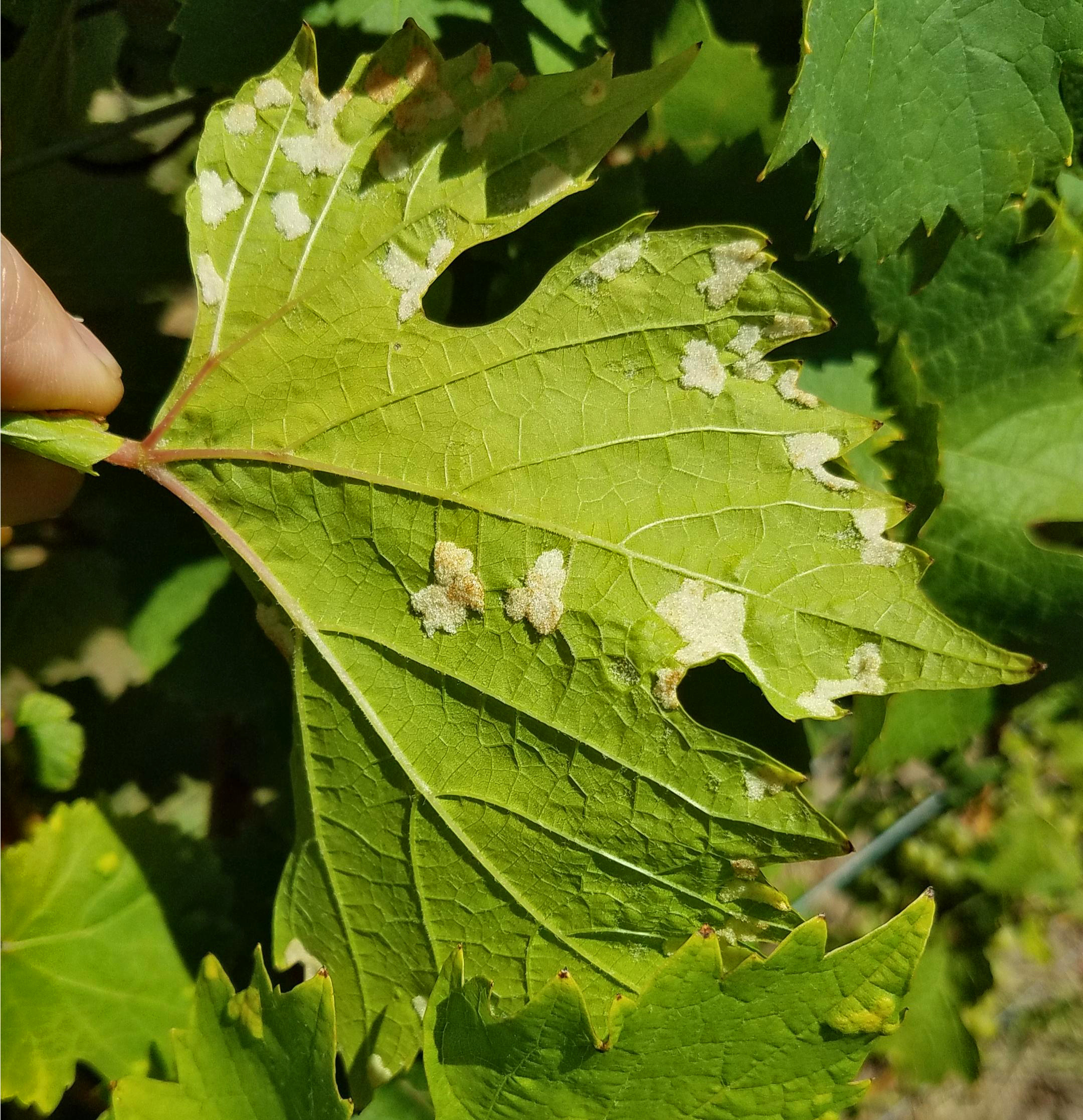
Related resources
- Michigan grape scouting report – August 19, 2020
- Southwest Michigan fruit update – August 25, 2020
- East Michigan fruit update – August 18, 2020
- A Mobile Guide for Grape IPM Scouting in North Central and Eastern U.S.
- Managing grapevine leafroll disease
- Michigan pesticide applicators receive temporary emergency license extension
- Agriculture support labs still open for business, with modifications
- August is key time for protecting clusters from grape berry moth
- Late season downy mildew control
- Do you suspect grapevine trunk disease in your vineyard?



 Print
Print Email
Email